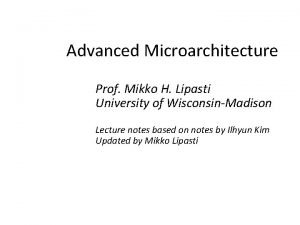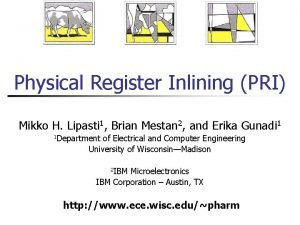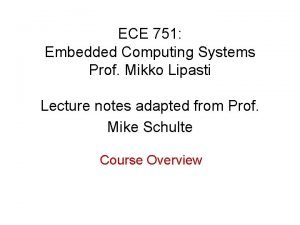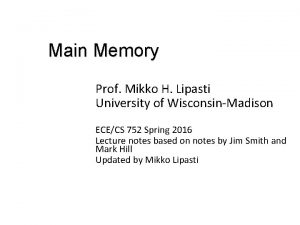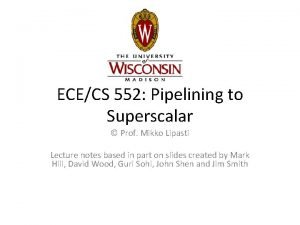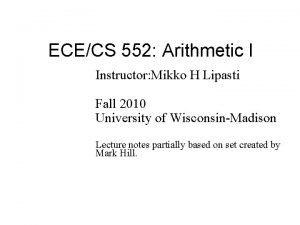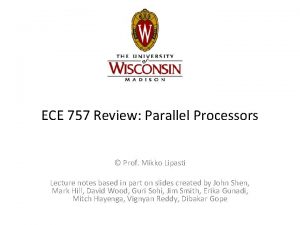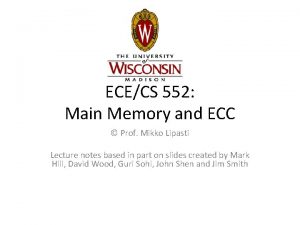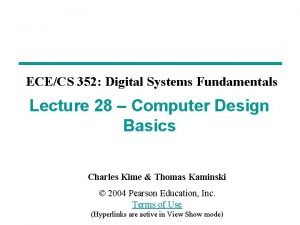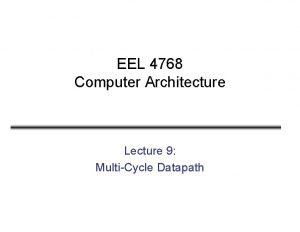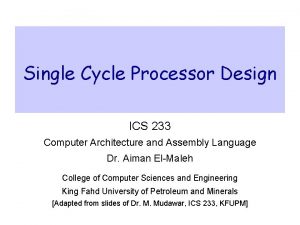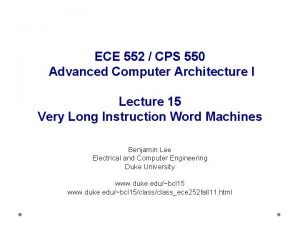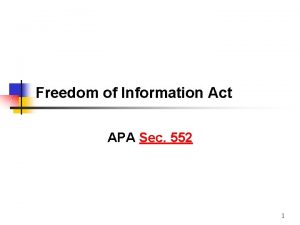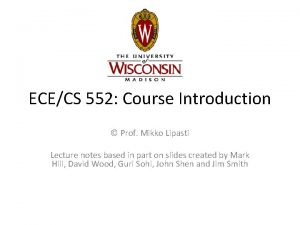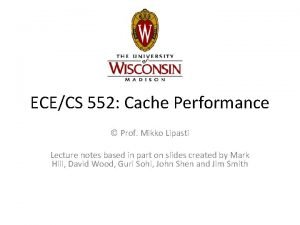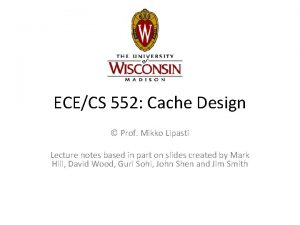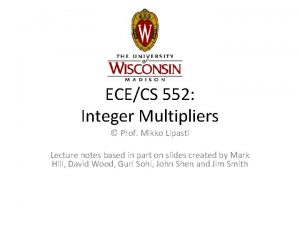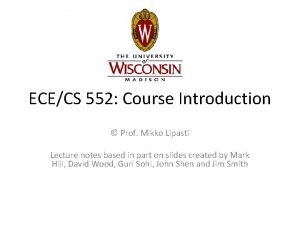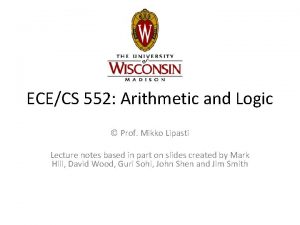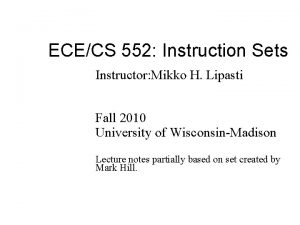ECECS 552 Single Cycle Datapath Prof Mikko Lipasti














![Load/Store Instructions • lw $1, immed($2) # $1 <= M[SE(immed)+$2] • E. g. MIPS Load/Store Instructions • lw $1, immed($2) # $1 <= M[SE(immed)+$2] • E. g. MIPS](https://slidetodoc.com/presentation_image_h/9d9dd6f435d8dcc4b77ec17e209f390d/image-15.jpg)





- Slides: 20

ECE/CS 552: Single Cycle Datapath © Prof. Mikko Lipasti Lecture notes based in part on slides created by Mark Hill, David Wood, Guri Sohi, John Shen and Jim Smith

Processor Implementation • Forecast – heart of 552 – key to project – Sequential logic design review (brief) – Clock methodology (FSD) – Datapath – 1 CPI • Single instruction, 2’s complement, unsigned • Next: – – Control Multiple cycle implementation (information only) Microprogramming Exceptions

Review Sequential Logic • Logic is combinational if output is solely function of inputs – E. g. ALU of previous lecture • Logic is sequential or “has state” if output function of: – Past and current inputs – Past inputs remembered in “state” – Of course, no magic

Review Sequential Logic • Clock high, Q = D, ~Q = ~D after prop. Delay • Clock low Q, ~Q remain unchanged – Level-sensitive latch

Review Sequential Logic • Master/Slave D flip-flop – While clock high, QM follows D, but QS holds – At falling edge QM propagates to QS – Opaque except at falling (rising) clock edge

Review Sequential Logic D FF +1 • Why can this fail for a latch? – Latch is transparent when clock is high (low) – Creates combinational loop – Increment evaluates unknown number of times

Clocking Methology • Motivation – Design data and control without considering clock • Use Fully Synchronous Design (FSD) – Just a convention to simplify design process – Restricts design freedom – Eliminates complexity, can guarantee timing correctness – Not really feasible in real designs: off-chip I/O – Even in ECE 554 you will violate FSD

Our Methodology • Only flip-flops • All on the same edge (e. g. falling) • All with same clock – No need to draw clock signals • All logic finishes in one cycle

Our Methodology, cont’d • No clock gating! – Book has bad examples • Correct design:

Delayed Clocks (Gating) Clock X D Delay Gated clock Clock X Delay Y • Problem: – Some flip-flops receive gated clock late – Data signal may violate setup & hold req’t Y D

FSD Clocking Rules Clock D Y • • • Clock Tclock = cycle time Tsetup = FF setup time requirement Thold = FF hold time requirement TFF = FF combinational delay Tcomb = Combinational delay FSD Rules: – Tclock > TFF + Tcombmax + Tsetup – TFF + Tcombmin > Thold Delay Y D

Datapath – 1 CPI • Assumption: get whole instruction done in one long cycle • Instructions: – and, lw, sw, & beq • To do – For each instruction type – Putting it all together

Fetch Instructions • Fetch instruction, then increment PC – Same for all types • Assumes – PC updated every cycle – No branches or jumps • After this instruction fetch next one

ALU Instructions • and $1, $2, $3 # $1 <= $2 & $3 • E. g. MIPS R-format Opcode 6 rs 5 rt 5 rd 5 shamt function 5 6
![LoadStore Instructions lw 1 immed2 1 MSEimmed2 E g MIPS Load/Store Instructions • lw $1, immed($2) # $1 <= M[SE(immed)+$2] • E. g. MIPS](https://slidetodoc.com/presentation_image_h/9d9dd6f435d8dcc4b77ec17e209f390d/image-15.jpg)
Load/Store Instructions • lw $1, immed($2) # $1 <= M[SE(immed)+$2] • E. g. MIPS I-format: Opcode 6 rt 5 immed 16

Branch Instructions • beq $1, $2, addr # if ($1==$2) PC = PC + addr<<2 • Actually new. PC = PC + 4 target = new. PC + addr << 2 # in MIPS offset from new. PC if (($1 - $2) == 0) PC = target else PC = new. PC

Branch Instructions

All Together

Register File?

Summary • Sequential logic design review (brief) • Clock methodology (FSD) • Datapath – 1 CPI – ALU, lw, sw, beq instructions
 Mikko lipasti
Mikko lipasti Mikko h. lipasti
Mikko h. lipasti Mikko h. lipasti
Mikko h. lipasti Mikko h. lipasti
Mikko h. lipasti Mikko h. lipasti
Mikko h. lipasti Mikko lipasti
Mikko lipasti Mikko h. lipasti
Mikko h. lipasti Mikko lipasti
Mikko lipasti Mikko h. lipasti
Mikko h. lipasti Mikko lipasti
Mikko lipasti Mikko lipasti
Mikko lipasti Mikko lipasti
Mikko lipasti Ececs
Ececs Difference between single cycle and multicycle datapath
Difference between single cycle and multicycle datapath Single cycle datapath
Single cycle datapath V clock
V clock Ece 552
Ece 552 Omd 552 hospital waste management
Omd 552 hospital waste management Maquinas resguardadas
Maquinas resguardadas Apa 552
Apa 552 +1 (617) 552-2015
+1 (617) 552-2015
